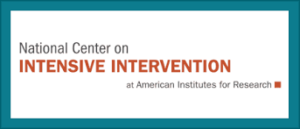Educator’s Edition-September 2025
Leading with Inclusion: Five Data Sources Every IEP Team Should Use
By Mackenzie Turbeville-McCorry, Ed.D.
___________________________________________________
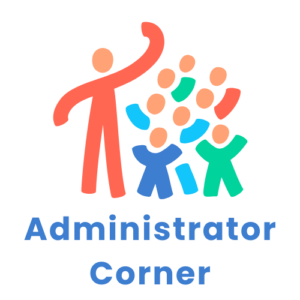
Building Data Literacy & Progress Monitoring Skills
by Cathy Buyrn, M.Ed.
School leaders can improve outcomes for all students by building the data literacy and progress monitoring skills of all stakeholders. When educators develop high levels of data literacy, they can make day-to-day instructional decisions and make the most of instructional time. When students and families understand assessment and progress monitoring data they take ownership of their own learning. School leaders can facilitate high levels of data literacy and progress monitoring skills by developing systems of support with clear expectations. Teachers need to understand what data needs to be collected, how often it should be collected, and how to use that data to drive instruction. While all students will benefit from high levels of data literacy and progress monitoring, students with disabilities need to experience instruction that accelerates the rate of skill acquisition to close critical skill gaps. When they participate in monitoring and graphing their own progress, they are more likely to build motivation and momentum towards challenging learning goals.
School leaders charged with supervising special education services are often driven by global school and division level data focused on compliance with state and federal targets. One of those targets monitored at the state and federal levels is Indicator 5a, which tracks the percentage of students with disabilities who spend at least 80% of their day in the general education classroom. This expectation has resulted in more inclusive class assignments but does not always result in the appropriate specially designed instruction (SDI) focused on individual student needs. School leaders need to monitor SDI and individual, student-specific progress monitoring data if they hope to meet more global targets. Students who are entitled to special education services must receive more than just time in the general education classroom. Students with Individual Educational Programs (IEPs) may receive accommodations or modifications of general education assignments, but they must also receive SDI focused on their own individual learning goals.
The Council for Exceptional Children (CEC) and The Collaboration for Effective Educator Development, Accountability, and Reform (CEEDAR) Center offer a framework of High-Leverage Practices (HLPs) for Students with Disabilities (2024). School leaders can use this framework to develop systems for building data literacy and progress monitoring skills. The HLPs are organized into four domains, and six pillar practices with embedded practices under each pillar. The summer edition of Link Lines, Integrating High-Leverage Practices for Students with Disabilities, offers an overview of the HLP domains and a description of how these practices can be integrated into systems of support.
This issue of Link Lines is focused on HLP 6: Data-Driven Planning (see Table 1). We start this Link Lines edition with this domain because educators start the year using student data to organize their instructional plans. Data from the previous school year is available for returning students and new assessments are conducted in the first few weeks of school. While we will be diving into each of the HLP domains this year, it is important to remember that the HLPs are intended to be integrated to promote student success.
Table 1
Data-Driven Planning Domain
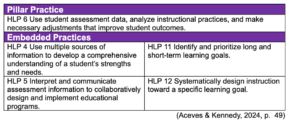
The relevant HLPs have been organized into a cycle of data-driven planning (see Figure 1) that school leaders can build into school and division level systems.
Figure 1
Cycle of Data-Driven Planning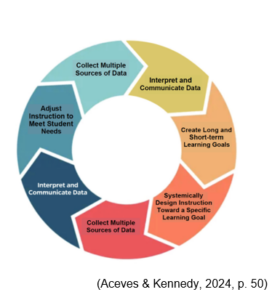
This cycle should be employed on a frequent basis to ensure that students are making progress towards challenging learning goals. School leaders should develop a system for monitoring these cycles. There are monitoring tools available to school leaders that can help build data-driven routines into school systems. The SDI Roles and Responsibilities Checklist (see Table 2) can be used to clearly establish who is responsible for components of the data-driven cycles.
Table 2
SDI Roles and Responsibilities Checklist
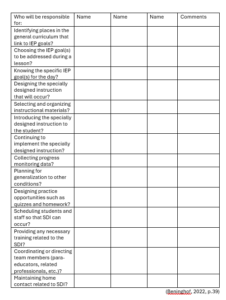
Once the roles and responsibilities for SDI have been clarified, school leaders can help teachers use an SDI Planning Matrix (see Table 3) to identify where in the master schedule they will provide IEP goal focused SDI.
Table 3
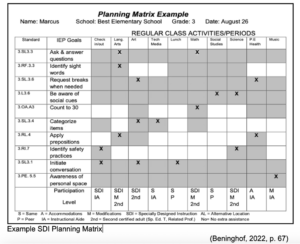
The SDI Planning Matrix can help school leaders identify appropriate times to conduct observations for SDI. It is important to make sure that SDI is being delivered and that weekly data is being collected on student progress. If skill progress is not monitored, special education services are not being provided satisfactorily (Sugita et al., 2023). Efficient progress monitoring data can help save valuable instructional time and lead to more targeted interventions.
School leaders should keep in mind that establishing accountability structures for data-driven planning cycles won’t accomplish much if teachers lack the tools or professional development needed to engage in these HLPs (Swain et al., 2022). Professional development resources and coaching support for school leaders and teachers can be accessed at the High-Leverage Practices website, the IRIS Center, CEC, and CEEDAR Center websites. The Training & Technical Assistance Center (TTAC) at William & Mary has provided HLP guidance through a recorded lunch and learn series designed to help educators develop the HLPs in their school contexts. School leaders across Virginia can also request direct assistance from their regional TTACs with professional learning and coaching focused on improving outcomes for students with disabilities through the HLPs.
Additional Resources
Leading with Inclusion: Five Data Sources Every IEP Team Should Use
https://intensiveintervention.org/
References
Aceves, T. C., & Kennedy, M. J. (Eds.). (2024). High-leverage practices for students with disabilities (2nd ed.). Council for Exceptional Children and CEEDAR Center.
Beninghof, A. M. (2022). Specially designed instruction: Increasing success for students with disabilities. Routledge.
Sugita, T., Busse, R. T., & Aryadad, A. H. (2023). After Endrew: Progress monitoring methods for supporting IEP teams. Contemporary School Psychology (Springer Science & Business Media B.V.), 27(2), 317–323. https://doi.org/10.1007/s40688-021-00389-y
Swain, K. D., Hagaman, J. L., & Leader-Janssen, E. M. (2022). Teacher-reported IEP goal data collection methods. Preventing School Failure, 66(2), 118–125. https://doi.org/10.1080/1045988X.2021.1980849





